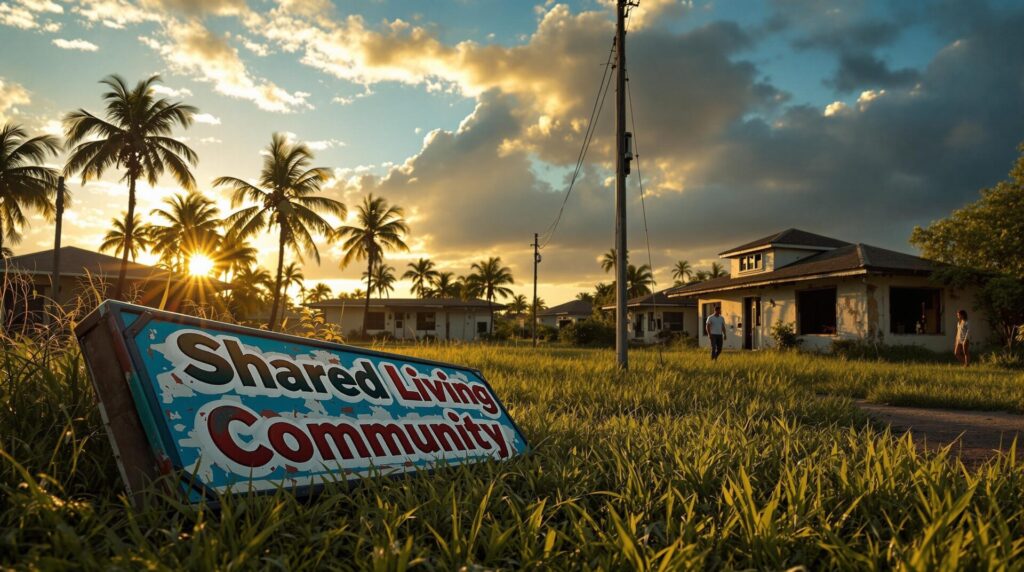Key Takeaways
- Co-living offers powerful cash flow potential for investors, but comes with increasing regulatory and legal risks.
- Major U.S. cities like Atlanta, LA, and NYC are embracing co-living as a partial solution to the housing affordability crisis.
- The downfall of Docked Living and others proves the co-living model can crumble quickly under legal scrutiny despite permits or popularity.

The Docked Dream That Became a Nightmare
In a shocking unraveling of what was once hailed as a revolutionary housing model, Docked Living — a St. Petersburg-based co-living operator — collapsed after fire officials deemed its single-family shared homes illegal rooming houses.
The enforcement sent dozens of tenants packing with just five days’ notice and reignited fierce national debate about the future of co-living in America.
What started as a vibrant answer to America’s growing cost-of-living crisis is now teetering on the edge of regulatory warzones, bankruptcies, and shaken investor confidence.
A Brief History of Co-Living in the U.S.
Modern co-living gained momentum in the early 2010s. As millennial renters flooded urban centers like New York, Los Angeles, and San Francisco, skyrocketing rents, wage stagnation, and dwindling social connections created a fertile environment for alternative housing. This shift in living arrangements was largely a response to the challenges millennials faced, especially as they navigated the complexities of adulthood amidst a U. S. housing market crisis explained by rising prices and a lack of affordable options. Co-living spaces offered not only a solution to financial constraints but also fostered community and collaboration among residents, which appealed to a generation seeking connection. As these innovative living arrangements proliferated, they began to redefine the traditional concepts of home and community in urban areas.
Startups like Common, Quarters, Starcity, and The Collective seized the moment, designing furnished homes with private bedrooms and shared kitchens.
Many pitched themselves as a lifestyle subscription, not a lease.
They sold affordability, community, and convenience to a generation priced out of homeownership.
The Economic Backdrop: Rising Costs and Housing Shortages
The numbers tell the story:
- Median rent in major cities: Over $3,000/month in cities like San Francisco and New York.
- Affordable housing shortage: More than 7 million homes needed for low-income renters, per the National Low Income Housing Coalition.
- Construction costs: Escalated due to inflation, tariffs, and labor shortages.
As housing options shrank and financial stress mounted, co-living became a lifeline — until the regulators came knocking.
Where Co-Living Is Booming: Top 10 U.S. Cities Embracing the Shared Living Surge
Despite mounting regulatory scrutiny in some jurisdictions, the co-living movement is far from dead.
In fact, it’s thriving in key urban markets across the U.S., where affordability, transient populations, and housing shortages are creating ideal conditions for high-density, shared-living solutions.
As of 2025, the following cities are leading the charge in co-living adoption.
Top 10 Cities Rapidly Embracing Co-Living in 2025
Atlanta, GA
PadSplit’s home turf, Atlanta has become the unofficial capital of affordable co-living. With massive demand from the city’s working-class and a favorable regulatory climate, investors continue piling in.Los Angeles, CA
Sky-high rents and a strong presence of gig workers, students, and creatives have made co-living one of the few viable entry points into LA’s brutal housing market.New York City, NY
Despite tough regulations, NYC continues to see demand for co-living, especially in boroughs like Brooklyn and Queens. Operators like Roomrs and Cohabs are actively expanding here.Houston, TX
With its no-zoning approach and explosive population growth, Houston offers co-living investors fewer bureaucratic hurdles and stronger ROI potential.Phoenix, AZ
Known for welcoming innovative housing models, Phoenix’s fast-growing population and relatively affordable real estate attract co-living operators seeking yield and scale.Chicago, IL
Neighborhoods near downtown and university hubs are driving Chicago’s co-living demand, especially among young professionals and international students.San Diego, CA
Coastal pricing and military transient populations have made co-living appealing here. The city has begun cautiously approving more high-density shared housing experiments.RELATED CONTENT
Austin, TX
With tech talent influx and housing shortages, Austin’s workforce seeks affordable alternatives. Co-living fits the lifestyle of many short-term tech contract workers and students.Miami, FL
Fueled by a growing remote work culture, international arrivals, and soaring rent prices, Miami has become a prime market for flexible, furnished co-living setups.Denver, CO
A city known for early adoption of housing innovation, Denver has embraced co-living as a tool to address affordability while preserving urban vibrancy.
These cities are combining rising rent burdens, shifting demographic trends, and investor-friendly ecosystems to create fertile ground for co-living to thrive.
For investors, these metros offer the best shot at scaling portfolios before local lawmakers tighten the grip on density-focused models.
The Fall of Co-Living Giants
Multiple co-living operators have now fallen:
- Common: Filed for Chapter 7 bankruptcy in 2024 after expanding too fast across 12 U.S. cities.
- Quarters: Medici Living’s U.S. offshoot collapsed in 2021 after a failed $300 million expansion.
- The Collective: Once operating across London and NYC, it went into administration in 2021.
- Starcity: Folded in 2021 due to cash flow and scale issues.
- HubHaus: Shut down after the pandemic made its lease arbitrage model unsustainable.
- WeLive: A residential spin-off from WeWork, WeLive was abandoned in 2021 after WeWork’s financial collapse and leadership scandals. It never scaled beyond a few locations and quietly shuttered amid shifting priorities.
Why Was Docked Living Shut Down?
Docked Living offered flexible membership housing in private rooms with shared living spaces — a model operating legally under single-family zoning.
But fire officials in St. Petersburg reclassified several of their properties as “rooming houses,” subject to stricter code. When Docked failed to install sprinkler systems or update fire protocols fast enough, city officials issued evacuation orders.
Docked claims it was targeted unfairly and had proper permits. Nonetheless, it crumbled under regulatory pressure, lawsuits, and public scrutiny.
Co-Living vs Airbnb, Pacaso, and Timeshares
Let’s break down how co-living stacks up against other popular shared housing models like Airbnb, Pacaso, and timeshares — and why the differences matter more than ever for today’s investors.
| Model | Ownership Type | Flexibility | Investment Potential | Regulatory Challenges |
|---|---|---|---|---|
| Co-Living | Rental | High | High (cash flow) | High |
| Airbnb | Rental | High | Medium–High | Very High |
| Pacaso | Fractional | Medium | High | Medium |
| Timeshares | Time-Based | Low | Low | Low |
While Airbnb dominates short-term rentals and Pacaso focuses on luxury fractional ownership, co-living provides high-density residential cash flow — often surpassing both on a per-square-foot basis.
Florida Co-Living Lawsuit: What Investors NEED to Know
A major co-living company in Florida just got shut down—despite having full permits. In this video, I break down exactly what happened, why this lawsuit should matter to every investor in 2025, and how you can protect your real estate business from the same risk. This is not just about zoning or permits. It’s about perception, politics, and how one powerful legal move can put your entire co-living strategy at risk. I’ll explain the one platform that provides built-in legal protection and why this could be your biggest shield in 2025. If you’re serious about affordable housing, passive income, or scaling with co-living, you cannot afford to miss this.
Jamil Damji
For Real Estate Investors: Co-Living’s Pros, Cons, and Caution Flags
As cities continue to battle housing shortages and affordability crises, co-living has captured the attention of real estate investors looking to maximize cash flow while providing a high-demand service.
The model can turn an average single-family home into a profit machine — but not without risks. Investors must weigh the benefits of rapid returns against the hazards of local pushback, legal complexity, and logistical headaches.
This section breaks down the key advantages and pitfalls of the co-living model for today’s investors.
The Pros
Massive Cash Flow Potential:
A standard 3-bed, 2-bath single-family home converted into a 6-bed co-living unit can generate 2–3x the rental income of a traditional lease. In some cases, investors report 30–50% cash-on-cash returns.Affordable Housing Demand:
With more than 50% of renters in the U.S. rent-burdened, co-living offers a way to create workforce housing without relying on government subsidies.Flexible Exit Strategies:
Properties can be resold as standard rentals, Airbnb short-terms, or even flipped to other investors — making co-living surprisingly adaptable.Strong Tenant Demand:
Urban professionals, traveling nurses, college students, and low-income earners are drawn to the affordability, social connection, and low barriers to entry.
The Cons
High Management Overhead:
More tenants = more turnover, more maintenance, and more headaches. Operators often need property management systems built for hotels, not rentals.Zoning and Regulatory Risks:
Cities like St. Petersburg, Denver, and San Diego have started cracking down. What was once considered a single-family home can be reclassified overnight.Community Pushback:
NIMBYs (Not In My Backyard activists) have launched complaints leading to surprise inspections and shutdowns, even when properties are fully permitted.Upfront Conversion Costs:
Renovating and furnishing rooms, upgrading electric panels, and soundproofing interiors can cost tens of thousands — long before any ROI appears.
Investor Warning
Co-living is not a passive investment. Legal, political, and operational risks can wipe out margins in a flash.
Without airtight permits, clear fire safety compliance, and contingency reserves, investors can quickly find themselves entangled in lawsuits or forced evictions like Docked.
Assessment
Co-living was once hailed as a messiah for America’s housing woes.
As Docked’s downfall demonstrates, a profitable model can still fall prey to political heat, legal ambiguity, and shifting regulations.
For real estate investors, the model remains extremely lucrative — but it requires more than just spreadsheets. It demands advocacy, risk management, and regulatory foresight.
Much like the early battles of Airbnb, co-living’s survival depends on whether cities will collaborate or crack down.
As housing affordability worsens and construction costs rise, co-living may still be one of the most effective — and dangerous — solutions in the modern housing arsenal.
Related Content:
- Las Vegas Housing Market Shatters Records Amid Economic Turmoil
- Trapped by Fees, Bankrupted by Boards: The HOA Nightmare Sweeping America
- Co-Living: Housing Revolution Sweeping Across U.S. (Win/Win or Rental Gotcha?)
- The U.S. Housing Apocalypse Continues (Why Your Real Estate Dreams Are About to Collapse)





















